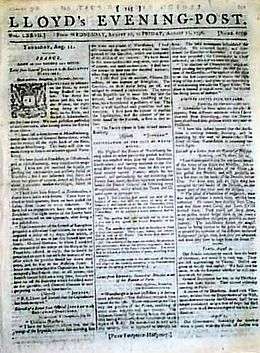Lloyd's Evening Post
Lloyd's Evening Post, also known as Lloyd's Evening Post and British Chronicle, was a British evening newspaper published tri-weekly in London from 1757 to 1808. Founded shortly after the London Chronicle and similar in format, it came out on Monday, Wednesday and Friday, alternating in "friendly rivalry" with the London Chronicle which came out on Tuesday, Thursday, and Saturday.[1]

History
The Lloyd's Evening Post was founded in July 1757 by James Emonson (a former partner of William Bowyer), and was published from Emonson's printing office in St John's Square, Clerkenwell. According to the colophon of the July 14–16, 1762 edition, copies of the paper could be purchased from W. Nicoll in St. Paul's Church Yard, and letters to the editor and advertisements were accepted at Lloyd's Coffee House and at the publisher's.[2]
John Rivington (1756–1785), a member of the Rivington publishing family, began working for Emonson in 1777 and took over the printing business when Emonson retired. Complicating matters somewhat was another tri-weekly, The London Packet, which was founded in 1771 and in 1777 changed its subtitle to "The New Lloyd's Evening Post".[3] The Lloyd's Evening Post issue for June 8–10, 1778 announced that the newspaper would henceforth be published by Rivington at 59 Paternoster Row.[4] From 1784 to 1790, the paper was published by J. Hancock at 23 Paternoster Row. It was subsequently published by Thomas Spilsbury and Son at 57 Snowhill.[5] The Spilsbury family remained its publishers until the paper's demise in 1808. For a few months in 1805, the Scottish writer Robert Heron served as the paper's editor. He had hoped to buy a share in it as well, but his perpetual financial difficulties made that impossible. Heron died penniless two years later in the fever ward of the St Pancras Workhouse.[6]
In the first decade of the 19th century, the rise of daily newspapers had led not only to the end of Lloyd's Evening Post but also several other tri-weekly publications such as the London Evening Post, the Evening Post, and the short-lived Inquisitor (published by John Browne Bell, the son of the literary publisher John Bell).[3] The London Chronicle, which by 1801 was selling twice as many copies as Lloyd's Evening Post (as indicated by the amount of stamp duty the papers paid), managed to hang on until 1823.[7]
Library collections
The Burney Collection of Newspapers at the British Library has digitized copies of the paper from 1757 to 1805.[8] The Guildhall Library holds the complete run to 1808 either in print or on microfilm.[9]
References
- Solomon, Harry M. (1996). The Rise of Robert Dodsley: Creating the New Age of Print, p. 331. Southern Illinois University Press. ISBN 080931651X
- OCLC 31802529
- Morison, Stanley (2009). The English Newspaper, 1622-1932, pp. 137; 183, 227. Cambridge University Press. ISBN 0521122694
- Fitzpatrick, Barbara Laning (2004). "Rivington family (per. c.1710–c.1960)". Oxford Dictionary of National Biography. Oxford University Press. Online edition retrieved 16 May 2014.
- Werkmeister, Lucyle Thomas (1967). A Newspaper History of England, 1792-1793, p. 26. University of Nebraska Press
- The Annual Register (1807). "Chronicle", pp. 566–567
- The Annual Register (1823). "London Newspapers in 1801", p. 350. J. Dodsley
- Gale/Cengage Learning. 17th – 18th Century Burney Collection Newspapers. Retrieved 16 May 2014.
- City of London. Guildhall Library Collections: Newspapers Archived 2014-05-17 at the Wayback Machine. Retrieved 16 May 2014.
External links
- Complete digitised copy of Lloyd's Evening Post, November 5–7, 1778 from the University of Florida George A. Smathers Libraries